Please note: Parts of this website will be included in the forthcoming CCI4Change publication, to be released by Xamk in December 2025. Therefore, if you wish to cite this material, please contact cai.weaver[at]xamk.fi. Thank you!
Role of the Local Authority in the Collaboration
You have the Power to Drive Change
Role of the Local Authority in the Collaboration
You have the Power to Drive Change
As a local authority you play a key role in building a more sustainable futures. You have the responsibility and thean opportunity to facilitate the behavioral change among citizens, promoting creative solutions., and connecting various stakeholders, such as citizens, creative professionals industries, and intermediary organizations to foster collaboration and change.
You are the driver of this collaboration and play a key role in enabling the exploration for more creative climate actions. procuring creative services and supporting the implementation of innovative solutions tailored to your community's needs.
To support your work, we offer a comprehensive toolkit designed to enhance your capacity to initiate new collaborations with the creatives with the aim to engage with communities for added sustainability.
These tools include guidelines for creative procurement, templates for cross-sectoral collaboration, and articles to understand more about participation or the role of art and culture in the green transformation. methods for effective citizen and community engagement. They support to help build the needed capacity to, deepen your understanding of creative sectors, and foster more innovative collaboration models needed for real change.

You have the Power to Drive Change
As a local authority you play a key role in building a more sustainable futures. You have the responsibility and thean opportunity to facilitate the behavioral change among citizens, promoting creative solutions., and connecting various stakeholders, such as citizens, creative professionals industries, and intermediary organizations to foster collaboration and change.
You are the driver of this collaboration and play a key role in enabling the exploration for more creative climate actions. procuring creative services and supporting the implementation of innovative solutions tailored to your community's needs.
To support your work, we offer a comprehensive toolkit designed to enhance your capacity to initiate new collaborations with the creatives with the aim to engage with communities for added sustainability.
These tools include guidelines for creative procurement, templates for cross-sectoral collaboration, and articles to understand more about participation or the role of art and culture in the green transformation. methods for effective citizen and community engagement. They support to help build the needed capacity to, deepen your understanding of creative sectors, and foster more innovative collaboration models needed for real change.
Your Creative Projects Can:
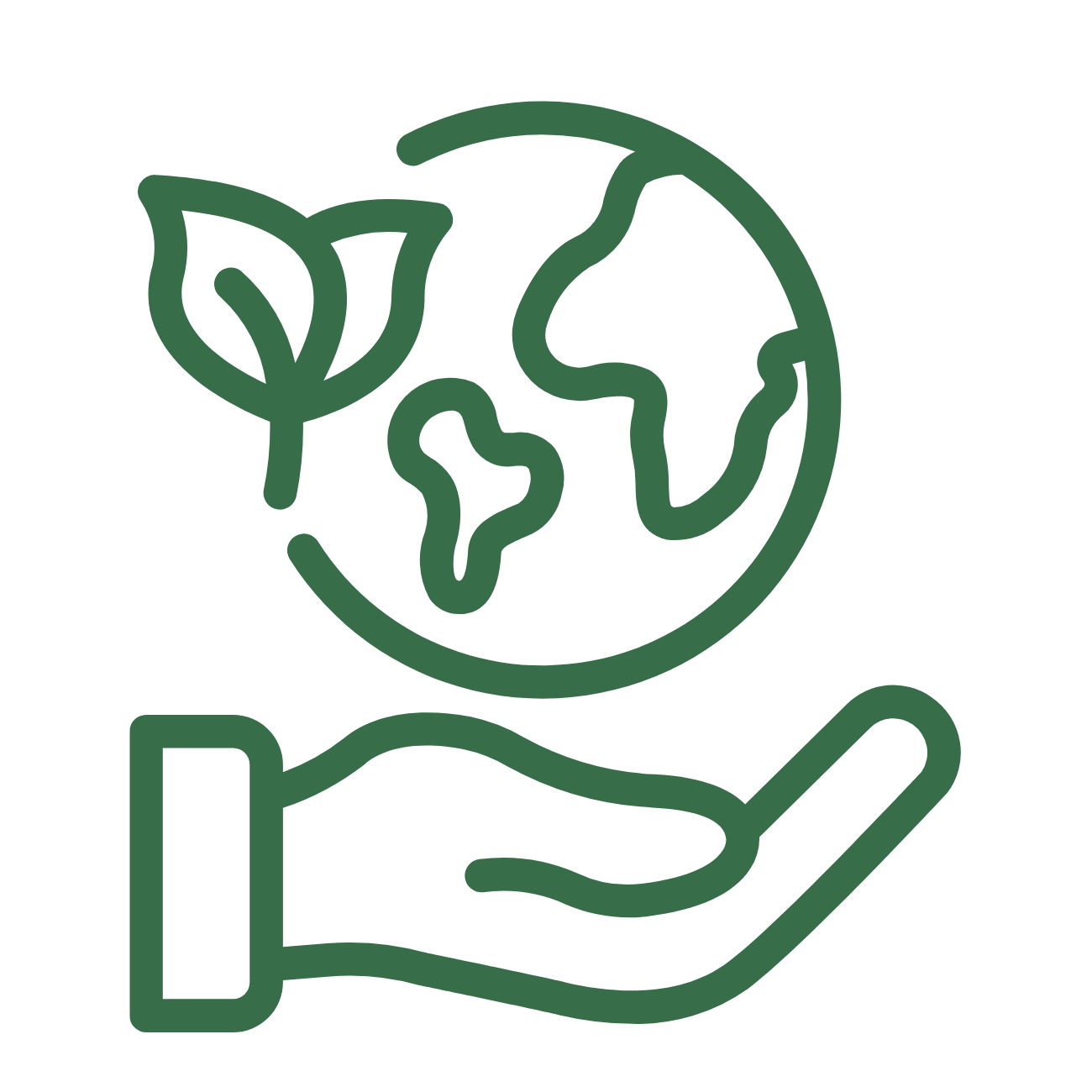
Raise the awareness about climate and sustainability issues!

Build creative experiences around issues that matter!

Enable participation and co-creation together with various communities!

Inspire citizens to think and to act differently!

Initiate new forms of cross-sectoral collaborations with creative professionals!

-and so much more!

Collaboration Model
The CCI4Change collaboration model aims to support partnerships between creative professionals and public authorities (officers at municipalities, cities and regions) to partner up, collaborate and enable creative climate actions for the wanted change. This visual model below outlines the collaboration journey – illustrating how creative professionals, intermediaries, and local authorities can join forces and work together toward a joint goal. It highlights the key phases of the CCI4Change process, the roles and actions of the collaborators, and the tools available to support each step.
We invite you to use this toolkit and collaboration model to initiate creative climate action within your local community — and , when collaborating with the local authority, to use the tools as a practical resource for building purposeful, impactful partnerships. The toolkit can be adapted to various contexts of climate action, sustainability goals, and social settings where artistic and creative approaches are included to address complex community challenges. In the CCI4Change project we worked with the goal of energy consumption behavioral change.
Explore the model and discover how structured, creative collaboration can help make climate action more effective, engaging – and transformative.
Explore the Toolkit on a desktop computer to access the full version and all materials!

Summary of Tools:
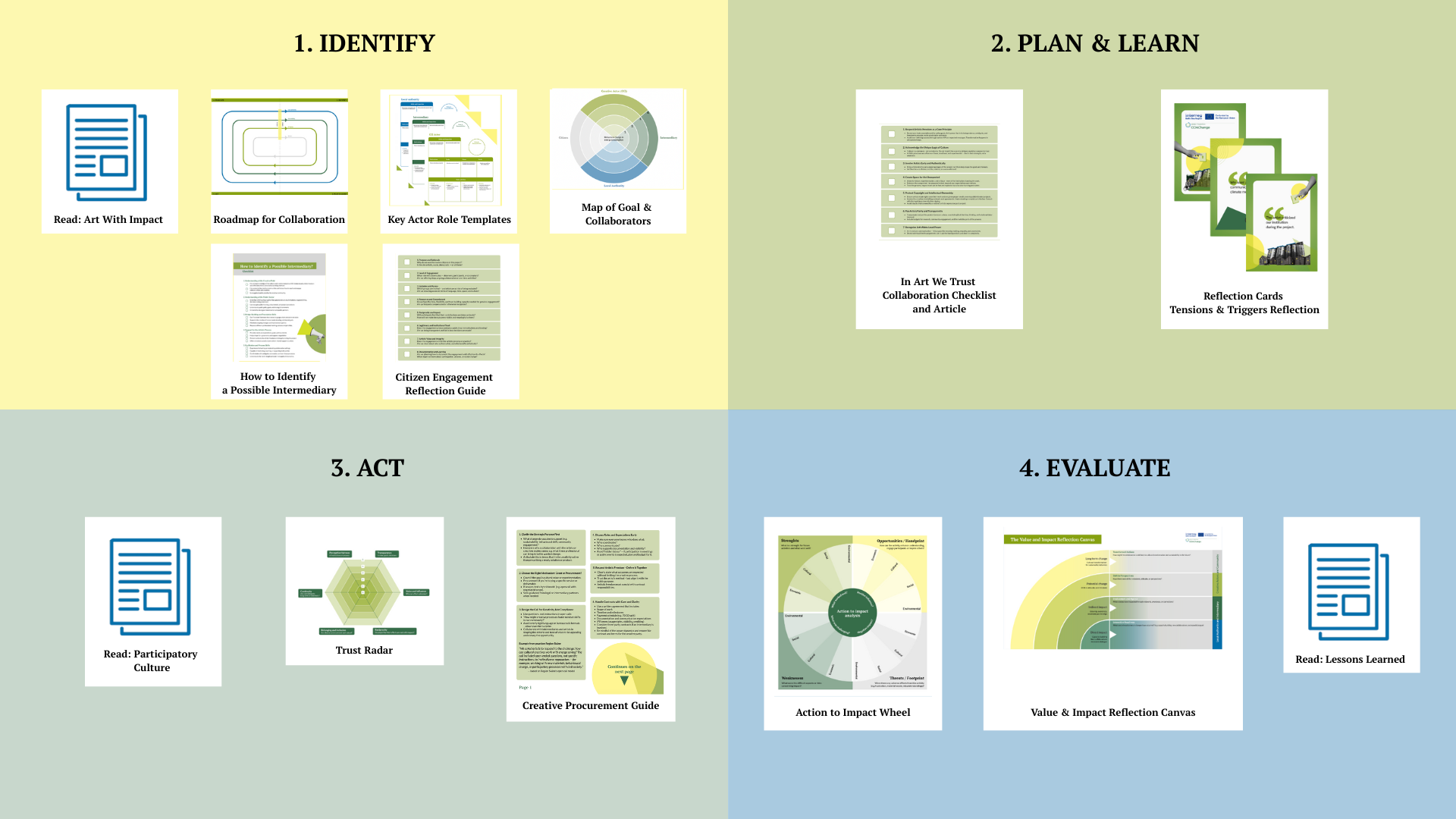
Steps:
1. Identify a concrete local climate or energy challenge. Think about how this issue is experienced in everyday life, how you relate to it, and what motivates you to work with itThink about how this issue is felt in everyday life, how you relate to it, and how working with it motivates you.
2. Ask yourself: What can creative approaches and the arts contribute to addressing this issue—something that facts alone cannot achieve? Consider which competencies and creative methods could be relevant.
3. Map interested parties in your own organization and possible stakeholders in your local area and region: Which people, organizations or specific communities could be involved? Consider involving citizens as early as possible to ensure relevance and shared ownership.
5. Identify an intermediary! A collaboration with the public authorities can benefit from an external intermediary party. Which organisation in your local community could serve as an intermediary party, support the initiation of a creative climate action CCI4Change process and build bridges towards the public officials?
Begin by identifying a local climate or energy-related challenge that feels meaningful and relevant to your community. This could be anything from promoting sustainable mobility or tackling issues like climate anxiety or strengthening community preparedness for future climate impacts. Rethink the issue and consider what artistic or creative approaches might achieve that traditional methods cannot: Art can challenge, connect, and reframe! Acknowledge relevant stakeholders in your organisation and beyond, and take first steps towards the practical collaboration.
STEPS:
1. Identify a concrete local climate or energy challenge. Reflect on how this issue is felt and lived-not just measured.
2. Ask yourself: What can art and creative methods bring to this issue that facts alone cannot?
3. Map relevant stakeholders in your own organization: Who should be interested about taking creative climate actions? Map also local stakeholders region who could share an interest in the issue. Consider the possibility to involve citizens early to ensure relevance, creativity, and shared ownership.
4. Identify an intermediary. A collaboration with the creatives benefits from an external intermediary party. Which organisation in your local community could serve as an intermediary, facilitate the collaboration and create outreach to the creative actors?

TOOLS:
Article: Art With Impact – Leveraging Culture for Green Transformation
How systems thinking can help art shape real change. How does real change happen in society? Not just symbolic gestures or temporary projects, but actual shifts in how we live, think, and relate to the world around us? This question has long concerned both system theorists and cultural practitioners. One of the most influential voices in this space is Donella Meadows, whose 1997 framework for systems change remains remarkably relevant – perhaps even more so today.
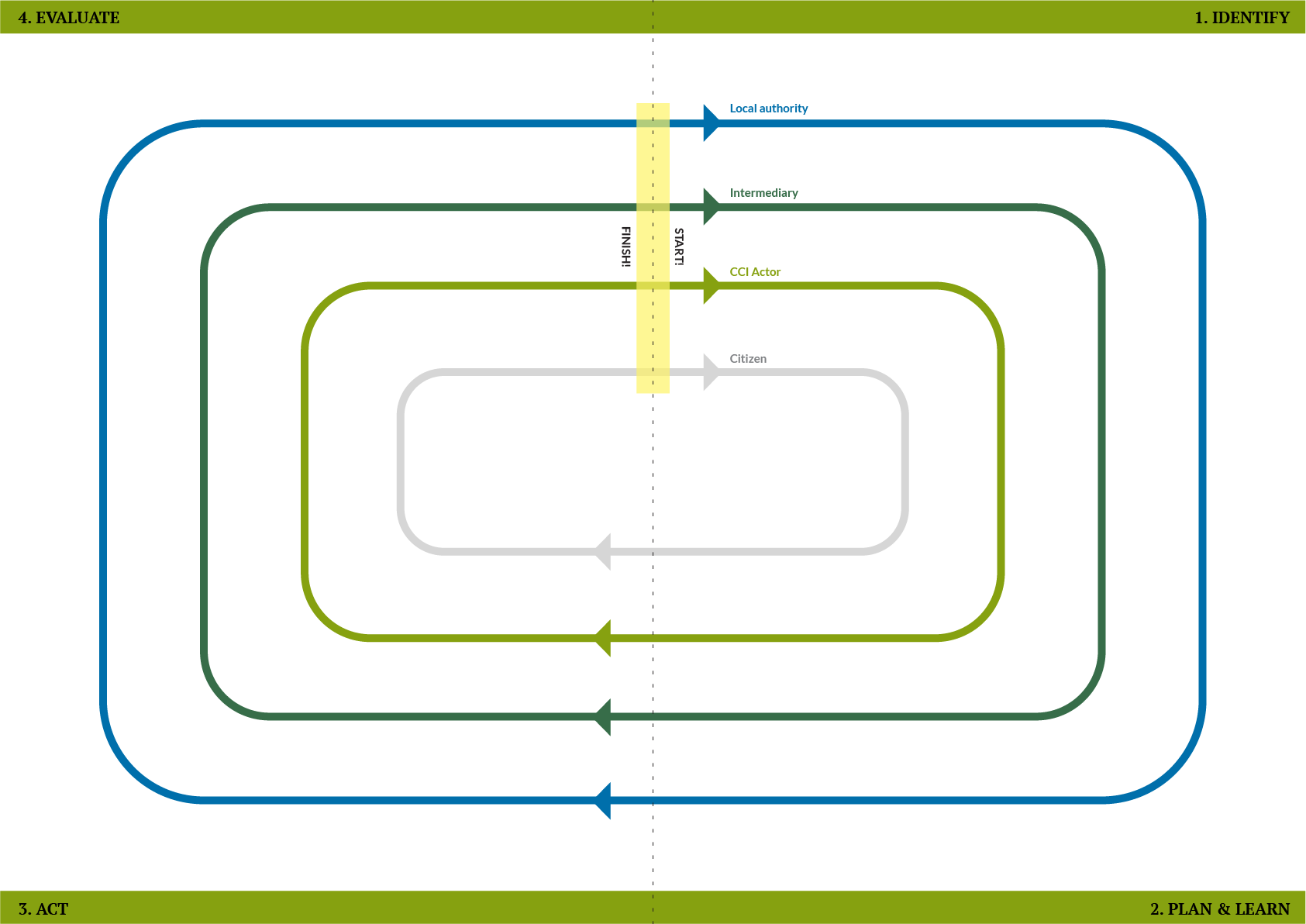
Roadmap for Collaboration
Roadmap for Collaboration is a step-by-step method that outlines how different actors are connected and how the actions of one stakeholder can trigger actions by others. The tool is designed for cross-sectoral collaboration, especially in the context of creative climate action, and was developed within the CCI4Change project.
The roadmap is based on a service blueprint method, adapted to clarify roles, actions, and timing in joint projects. It visualizes how local authorities (as project leads), intermediaries, creative actors, and citizens progress through a collaborative process together. The roadmap highlights each role’s contributions along a shared timeline and helps ensure synchronized progress.

Key Actor Role Templates
The tool supports actors of collaboration to understand the different roles the project entails, key activities and contributions. Each key actor in the CCI4Change collaboration —such as a local authority, an intermediary, and or a creative actor—has their own template to fill in. The tool is useful especially in the planning phase of the project, to clarify the responsibilities of each actor.
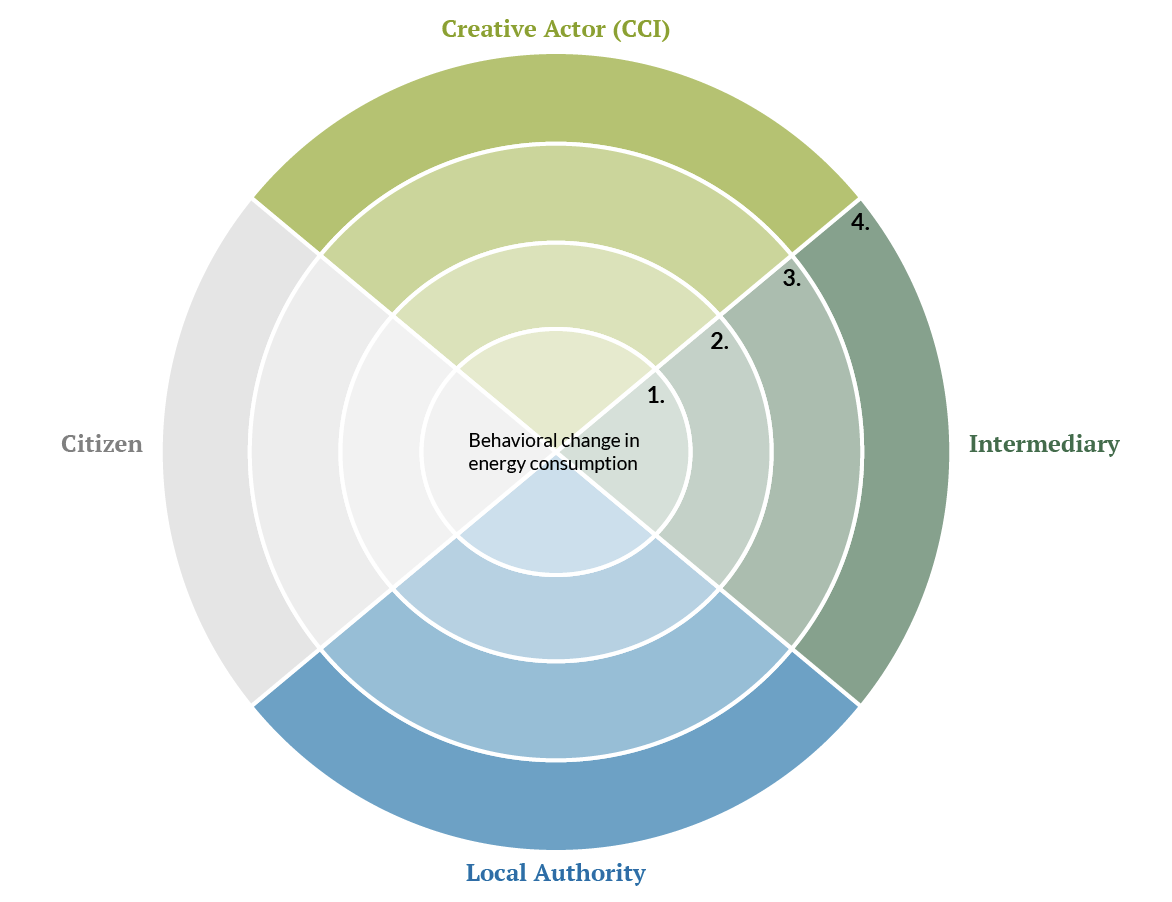
Map of Goal & Collaborators
The purpose of this tool is to foster strong and meaningful collaboration by visualising both the partners and the shared goal within a single image. The Map is an adaptation of the stakeholder mapping tool, commonly used to identify the parties involved in a collaboration. The idea for this new application emerged from the need to reinforce a shared goal and keep it clearly in the minds of all participants. The tool is designed to implement the CCI4Change collaboration model for creative climate action. These key actors in the collaboration are pre-visualised in the image, each playing a vital role in creative climate action.

How to Identify a Possible Intermediary
Creative climate action collaborations and creative-public collaborations in general, the intermediary plays a crucial bridging role between local authorities and professionals from the culture and creative industries (CCI). This function supports trust-building, communication, and process facilitation — ensuring that both public-sector goals and artistic integrity are respected.

Action to Impact Wheel
Action to Impact Wheel is a practical tool that supports creative teams in understanding how their activities translate into real-world impact. It is based on sustainability thinking and inspired by the familiar SWOT model (Strengths, Weaknesses, Opportunities, Threats), but adapted with a focus on the broader dimensions of sustainable development.
The tool encourages users to consider the link between their actions and impact, especially in the context of the UN Sustainability Development Goals (SDG). It helps you explore how creative actions support or challenge sustainability — both locally and globally.

Citizen Engagement - Reflection Guide
This tool helps cultural and creative project partners reflect on the meaning, design, and impact of citizen engagement. Citizen engagement in this context is not simply about participation as audience, but active involvement in shaping the process and outcomes.
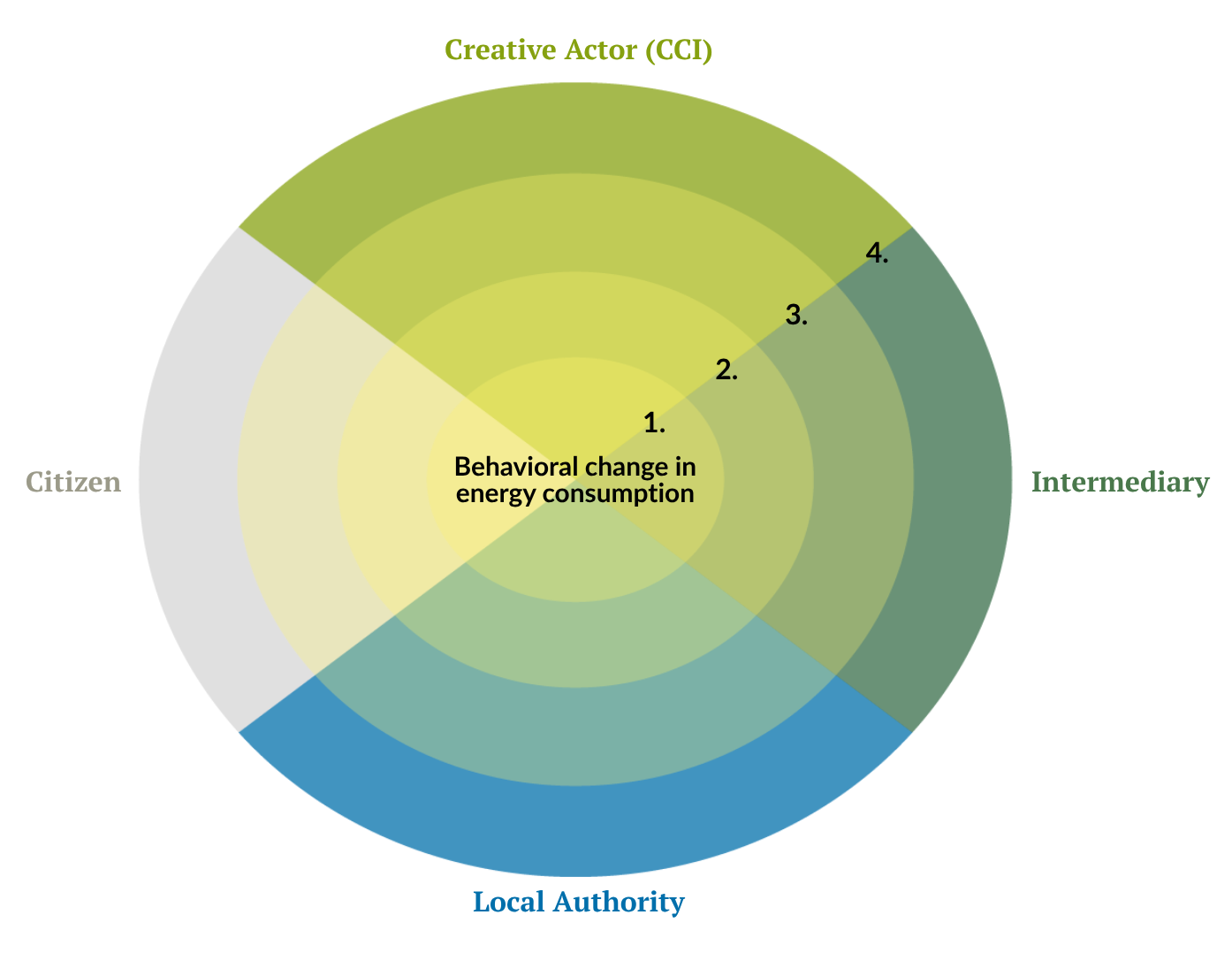
In this phase, the local authority takes the lead in structuring the collaboration—defining its goals, scope, and expectations. This is a moment to co-design the process together with the intermediary party, ensuring clarity around roles, responsibilities, timelines, resources, and administrative procedures. The local authority creates the conditions for meaningful creative work while allowing flexibility for experimentation and learning along the way. In practical terms, the local authority, with the support of the intermediary party, prepares capacity-building efforts, designs the open call process, and establishes the essential criteria to invite creative actors to propose their climate actions for implementation.
STEPS:
1. With intermediary support, organise capacity-building sessions to raise awareness among local authorities about creative climate actions.
2. Secure funding for the creative pilots. Prepare administrative processes, learn about possible procurements and needed agreements.
3. With intermediary support, prepare the open call criteria and clarify the expectations for the activities.
4. With intermediary support offer capacity-building support to creative professionals to strengthen the dialogue and the attention to the open call.
5. Clarify process phases and the roles and expectations of the different parties. Consider the possibility to involve citizens early to ensure relevance, creativity, and shared ownership.

TOOLS:
In Art We Trust – Collaboration Checklist and Article
A practical tool for meaningful partnerships between artists and public authorities
This checklist-based tool supports fair, respectful, and effective collaboration between public authorities, intermediaries, and artists working on impactful projects. It is rooted in the recognition that art and culture offer unique ways of addressing complex challenges—and that this potential can only be realized if artistic freedom and cultural logic are preserved.
Creative Procurement Guide for Local Authorities
The Reflection Cards: Tensions & Triggers is a discussion-based tool designed to explore and address sensitive dilemmas that may arise in collaborative cultural projects. It focuses on situations where local authorities, artists, intermediaries, and civil society actors work together — but experience friction.
Each card presents a real-world tension or triggering situation related to artistic freedom, institutional expectations, or public reaction. The purpose is not to solve these dilemmas in a standardized way, but to create space for honest reflection, strengthen mutual understanding, and build more resilient partnerships.
This tool is grounded in the principle that art must remain free and that intellectual property rights are fundamental, not only for democratic integrity but also for artists’ livelihoods.
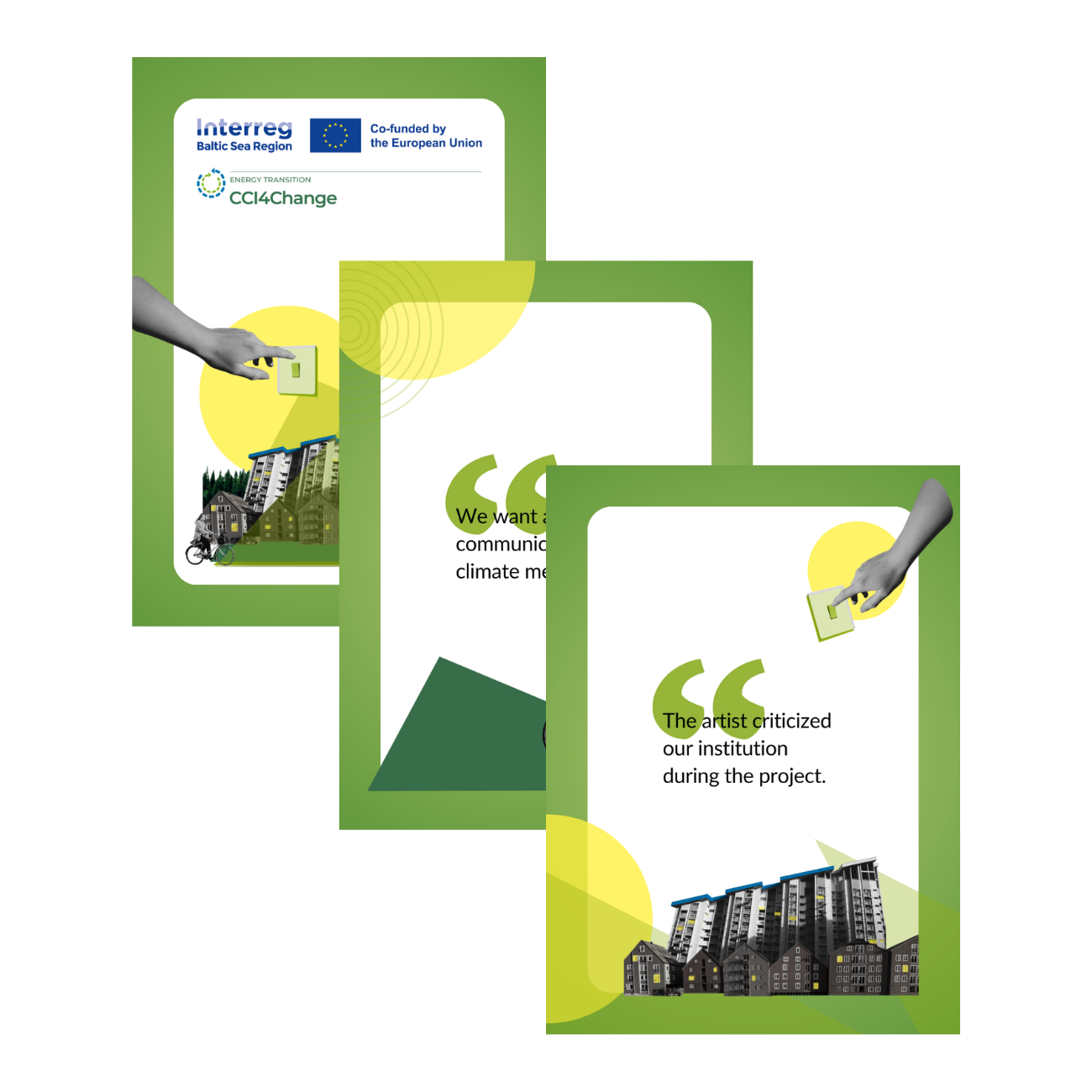
Reflection Cards – Tensions & Triggers Reflection
The Reflection Cards: Tensions & Triggers is a discussion-based tool designed to explore and address sensitive dilemmas that may arise in collaborative cultural projects. It focuses on situations where local authorities, artists, intermediaries, and civil society actors work together — but experience friction.
Each card presents a real-world tension or triggering situation related to artistic freedom, institutional expectations, or public reaction. The purpose is not to solve these dilemmas in a standardized way, but to create space for honest reflection, strengthen mutual understanding, and build more resilient partnerships.
This tool is grounded in the principle that art must remain free and that intellectual property rights are fundamental, not only for democratic integrity but also for artists’ livelihoods.

In this phase, the collaboration moves from planning to action by launching creative projects to engage communities! The process begins with announcing and promoting the open call to attract artists and creative professionals whose skills and approaches match the goals of the collaboration. After selecting and commissioning the creative actors, formal agreements are made to clarify roles, expectations, and working conditions. The collaboration then kicks off, setting the stage for the creatives to begin their work—co-creating climate actions that connect with the community, raise awareness, and inspire change. This is the moment where creativity meets climate action on the ground.
STEPS:
1. With intermediary support, announce and promote an open call for artists & creatives to propose their creative climate actions.
2. With intermediary support, select and commission creative actors to collaborate and implement their creative projects in communities.
3. Kick-start the collaboration with the chosen actor(s) and make needed agreements.
4. Define expectations, roles and responsibilities with the creative actor(s). Offer practical support to the implementation of the creative projects as in support in accessing the communities, spaces or permits.
5. Support the evaluation, documentation and communication of the creative actions.
TOOLS:

Article: Participatory Culture
“Participatory” – it’s a tricky word, but by the time you’ve learned how to pronounce it, you’ve probably also begun to understand what it means. On an informal level, the phenomenon has likely existed since the first groups of Homo sapiens wandered along the shores of the African continent. Humans are social creatures, and various forms of collaboration, ownership, and collectivism are deeply rooted in our DNA (just like less flattering traits such as egoism, racism, and a propensity for violence…). That said, the term participatory culture is a more recent invention.

Trust Radar – A Tool for Building Trust
Trust Radar is a simple yet powerful tool designed to help actors understand and strengthen trust in collaborative and
participatory projects. It offers a structured way to reflect on how trust is perceived and experienced among different
actors — especially in socially engaged, cross-sectoral, or creative processes.
Rooted in Nordic traditions of transparency, inclusion, and mutual recognition, the tool can be used at different phases
of a project: during planning, mid-point check-ins, or final evaluations.
Creative Procurement Guide for Local Authorities
This guide helps local authorities work more confidently and effectively with artists in public-sector, sustainability- or citizen-focused projects. It supports you in:
-
Choosing the right commissioning model (grant or procurement)
-
Designing artist-friendly and goal-oriented open calls
-
Building clear, fair and transparent contracts
-
Creating better outcomes through mutual understanding
The final phase focuses on reflection, learning, and planning for legacy. Evaluation is not just about measuring outcomes but also about understanding the collaboration process: What worked, what could be improved, and how the creative approaches contributed to climate action and community engagement? Participatory evaluation methods can provide knowledge from the experience of the participants and can be performed in creative manners. Importantly, this phase looks towards the future: exploring how the collaboration, methods, or projects can be scaled and developed to create a more lasting impact.
STEPS:
1. Support and conduct participatory evaluations. Involve all stakeholders to understand the value of the collaboration, gather diverse insights and facilitate discussions around value of the collaboration.
2. Conclude the collaboration with the intermediary and the creative actor(s), acknowledge the communities and stakeholders who took part in the creative climate action project(s).
3. Share results of the collaboration by communicating to diverse audiences. Build the narrative and story also to the ones who were not directly involved. Utilise the local authority channels to share the learnings.
4. Explore possibilities for scaling or repeating. Assess opportunities to expand or replicate successful projects and embed creative approaches into ongoing local authority processes and parallel initiatives.
5. Seek strategic support through relevant policies and strategies. Clearly articulate how the collaboration advances citizen-driven and creative approaches within public initiatives.

TOOLS:
Action to Impact Wheel
Action to Impact Wheel is a practical tool that supports creative teams in understanding how their activities translate into real-world impact. It is based on sustainability thinking and inspired by the familiar SWOT model (Strengths, Weaknesses, Opportunities, Threats), but adapted with a focus on the broader dimensions of sustainable development.
The tool encourages users to consider the link between their actions and impact, especially in the context of the UN Sustainability Development Goals (SDG). It helps you explore how creative actions support or challenge sustainability — both locally and globally.

Value & Impact Reflection Canvas
The Value & Impact Reflection Canvas is a tool designed to help collaborators reflect on and articulate the different
dimensions of value and impact that emerge from cultural collaborations. It acknowledges that many of these impacts
are subtle, long-term, and difficult to measure, yet no less meaningful or essential.
This tool is especially useful in contexts like CCI4Change, where the effects are embedded in relationships, mindsets,
narratives, and new connections rather than in immediate quantitative results. It supports shared understanding
between stakeholders by prompting discussion on what kind of impacts are expected, what might be explored or
tracked, and which forms of value should be acknowledged, even if they cannot be measured directly.
Lessons Learned – Reflecting on Collaboration
This tool helps local authorities and project teams reflect on what they’ve learned from creative climate action initiatives—particularly those involving collaboration with artists and citizen engagement. It is based on real-world pilot cases and identifies what made participation meaningful, partnerships successful, and impact possible.
It is best used after a project ends or between project phases to capture insights, improve future planning, and institutionalize learning across departments and partners.
1. Identify
Purpose:
Begin by identifying a local climate or energy-related challenge that feels relevant to your community. Rethink the issue, consider what artistic approaches could achieve that traditional methods can not. Art can challenge, connect, and reframe.
Steps:
A collaboration with the creatives benefits from an external intermediary party. Who in your local community could serve as an intermediary, facilitate the collaboration and create outreach to the creative community?
Ask: Which departments in your organisations should be interested about this theme and how to build shared ownership of the collaboration?
Consider which competencies, values, and artistic methods might support collaboration
Map relevant stakeholders in your region
Involve citizens early to ensure relevance, creativity, and shared ownership
Key tools:
Action to Impact Canvas
Key Actor Role Templates
Stakeholder Mapping
Tips for Co-Creation
Tips for Citizen Engagement
2.Plan & Learn
Purpose:
Develop skills and structure collaboration.
Steps:
1. Organize capacity building sessions
2. Clarify roles & expectations
3. Learn about procurement processes
4. Prepare financial resources and administrative process
5. Prepare agreements
Key tools:
Capacity Building Framework
Art related procurement guide
Case Studies with Best Practices & Lessons Learned
Tips for Visibility strategies
3. Act
Purpose:
Launch creative projects and engage communities.
Steps:
1. Announce and promote an open call for artists & creatives
2. Select and commission creative actors
3. Make agreements
Key tools:
Roadmap for collaboration
Agreement template
4. Evaluate
Purpose:
Reflect on the process, measure impact, and plan for legacy.
Steps:
1. Conduct participatory evaluation
2. Share results
3. Explore possibilities for scaling or repeating
4. Evaluate value & impact
Key tools:
Value and impact frameworks
Action to Impact Analysis







